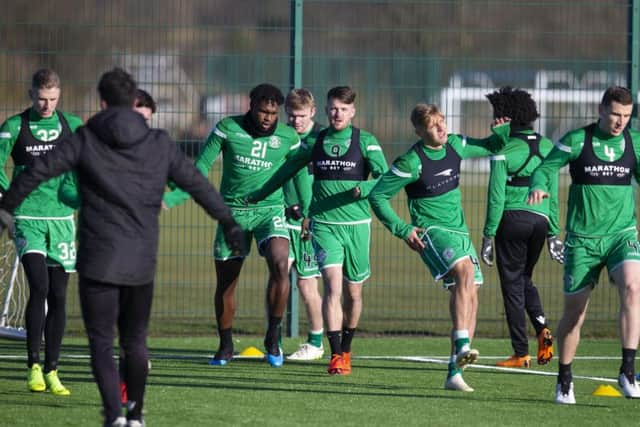Hibs analysis: How team shapes up after the January transfer window
Despite the upheaval, Hibs do have a competitive - if not perfect - squad to go into the second half of the season with. The immediate goals will be to break back into the Premiership’s top six - sixth-placed St Johnstone are five points clear of them - after an alarming slump in October and November that saw them hurtle down the table from second place, and also to progress in the William Hill Scottish Cup. Hibs host League One outfit Raith Rovers for a place in the quarter-finals. Without belittling the Kirkcaldy side, that’s a pretty generous draw.
Hibs secured European football last season, but they will need to kick on pretty quickly if they are to challenge for those spots. Currently seventh-placed and 12 points off the Europa League berths, a big run is needed to throw them into contention. Therefore the cup takes even more importance than usual.
Advertisement
Hide AdAdvertisement
Hide AdHibs lost arguably their player of the season in Efe Ambrose at the start of last month. Bizarrely, the Nigerian defender is still without a team going into February. Hibs did try to lure him back in as the window came to its end and the severity of Ryan Porteous’ knee injury became apparent. In the end, Leicester City’s hulking 20-year-old Darnell Johnson came in to augment centre-half options. With Porteous out for the season, Johnson - who captained England Under-19s to European Championship glory in 2017 - appears a direct replacement for him. Ambrose, of course, can still sign for Hibs as a free agent, but a move to England looks likelier.


Reinforcements have arrived in midfield, an area that has caused the most grief for Hibs this season. Replacing the talismanic trio of John McGinn, Dylan McGeouch and Scott Allan was always going to be difficult and one of Lennon’s biggest issues before he departed was getting the blend right. Emerson Hyndman returned to Bournemouth after his six-month loan deal expired, with the American never really influencing proceedings enough to be deemed a veritable success. Ryan Gauld, brought in from Sporting CP in Portugal, is a clear upgrade. He is still recalibrating his game after so long away from Scottish football, but there is no doubt he will add guile and intelligence to the Hibs midfield. Genoa loanee Stephane Omeonga is an unknown, but his pedigree suggests a combative, box-to-box player. Gael Bigirimana’s deadline-day arrival came out of the blue, but the signing from Motherwell could surprise a few people. He is another clever player who likes to pass the ball and perhaps Hibs’ style will be more to the Burundi internationalist’s liking than in North Lanarkshire.
Of course, Scott Allan dominated the whole window, as is becoming the norm. At least with his three-year pre-contract deal confirmed, we won’t have to speculate on him next summer. Hibs tried to get Allan over to Edinburgh in this transfer period but negotiations with Celtic were fruitless. It would be fair to state that Allan’s preference was to make the move to Easter Road during the window, but circumstances were outwith his control. In essence, Gauld brings the stardust he possesses, although you can never have too many good players and Allan and Hibs are a match made in heaven.
In attack, the capture of Reading striker Marc McNulty seems shrewd. McNulty isn’t in the picture under new Royals boss Jose Gomes, but clearly has ability. He returns north a much better player than the one that left Livingston in 2014. He is a goalscorer, able to hit it off both sides with good movement. His arrival allowed wantaway Jamie Maclaren to depart in a drawn-out affair for Melbourne City. Maclaren and Lennon fell out and his first-team displays became limited. While the Australian internationalist is, in this spectator’s eyes, an above-average striker at Premiership level, a motivated McNulty is a better bet than a disillusioned Maclaren and Hibs will now hope to kindle a partnership between McNulty and main hitman Florian Kamberi, who will be looking to bounce back after an underwhelming first half of the season. A new head coach will surely help the Swiss in that regard.
Outside of Kamberi and McNulty, Hibs’ striking options lie with youngsters Oli Shaw and Lewis Allan. While Shaw has shown some promise at Premiership level, the latter has found the going tough. Hibs do need to keep Kamberi and McNulty fit to make sure the goals don’t rest on the shoulders of Shaw, 20, who is still developing, and 22-year-old Allan, whose first-team experience in the top flight is minimal.
Third-choice goalkeeper Ross Laidlaw departed for Dundee United and right-back Charis Mavrias left after a brief spell at Easter Road. Their absences are unlikely to be missed, although Martin Boyle’s season-ending knee injury leaves a big hole on the flanks. Daryl Horgan and Thomas Agyepong, who is nearing full fitness, are Hibs’ only recognised wingers. Teenger Fraser Murray, beseiged by injury but now back in the first-team fold, can operate as a winger, but if one thing can be labelled against the current squad, it is options out wide and a genuine pace outlet. The squad looks more suited to narrower formations with full-backs David Gray and Lewis Stevenson providing the width.
However, considering the behind-the-scenes tumult at Hibs over the past few weeks, the club has done reasonably well to make sure it can compete with its rivals for the rest of the campaign. Lennon’s departure was ill-timed in the fact that it coincided with a recruitment drive. It is not easy to attract players when you don’t have a manager. The proof, though, will be in the pudding. At least whoever lands the new head coach role has the crux of a promising squad to work with in an important second half of the 2018/19 campaign.